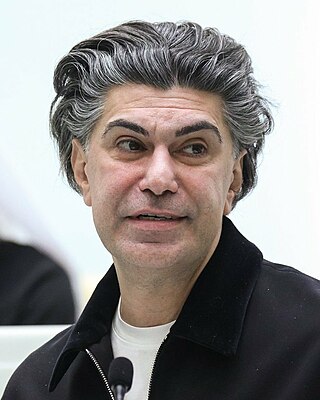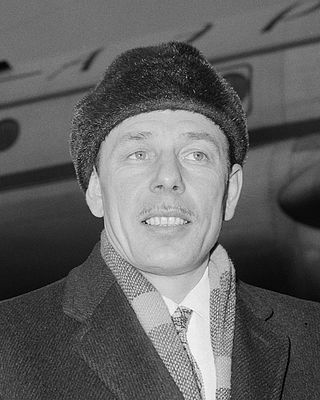Related Research Articles

The Vaganova method is a ballet technique and training system devised by the Russian dancer and pedagogue Agrippina Vaganova (1879–1951). It was derived from the teachings of the Premier Maître de Ballet Marius Petipa, throughout the late 19th century. It was Agrippa Vaganova who perfected and cultivated this form of teaching classical ballet and turned it into a viable syllabus. The method fuses elements of traditional French style from the romantic era with the athleticism and virtuosity of Italian Cecchetti technique. The training system is designed to involve the whole body in every movement, with equal attention paid to the upper body, legs and feet. Vaganova believed that this approach increases consciousness of the body, thus creating a harmony of movement and greater expressive range.

Russian ballet is a form of ballet characteristic of or originating from Russia.

Agrippina Yakovlevna Vaganova was a Soviet and Russian ballet teacher who developed the Vaganova method – the technique which derived from the teaching methods of the old Imperial Ballet School under the Premier Maître de Ballet Marius Petipa throughout the mid to late 19th century, though mostly throughout the 1880s and 1890s. It was Vaganova who perfected and cultivated this form of teaching the art of classical ballet into a workable syllabus. Her Fundamentals of the Classical Dance (1934) remains a standard textbook for the instruction of ballet technique. Her technique is one of the most popular techniques today.

Nikolay Maximovich Tsiskaridze PAR is a Georgian-Russian ballet dancer who had been a member of the Bolshoi Ballet for 21 years (1992–2013).

The Vaganova Academy of Russian Ballet is a school of classical ballet in St Petersburg, Russia. Established in 1738 during the reign of Empress Anna, the academy was known as the Imperial Ballet School until the Soviet era, when, after a brief hiatus, the school was re-established as the Leningrad State Choreographic Institute. In 1957, the school was renamed in honor of the pedagogue Agrippina Vaganova, who cultivated the method of classical ballet training that has been taught there since the late 1920s. Many of the world's leading ballet schools have adopted elements of the Vaganova method into their own training.

István Martin is a Franco-Hungarian ballet dancer.

Tatiana Viktorovna Stepanova, also Tetiana Stepanova, is a Ballet master, choreographer, ballet dancer, critic, essayist and historian of the dance.

Michelangelo Canale is an American dancer, teacher, choreographer and artistic director of ballet.

Keenan Kampa is an American actress and dancer.

Igor Dmitrievich Belsky was a Russian ballet dancer and choreographer. After 20 years of solo work (1942–62) he became a chief choreographer of Maly Theatre (1962–73), artistic director of Kirov Ballet (1973–77), artistic director of Cairo Ballet (1977–78), chief ballet master at the Leningrad Music Hall (1979–92), and artistic director of the Vaganova Academy of Russian Ballet.

Peggy Willis-Aarnio was an American choreographer, historian, author and teacher of classical ballet. She was a professional dancer in the early 1970s with the Ft. Worth Ballet in Fort Worth, Texas. She was the first American ballet teacher to be sanctioned as a "Certified Practitioner and Teacher of the Teaching Method of Classical Ballet" by the Vaganova Academy in Saint Petersburg, Russia.
Boris Knyazev was a Russian ballet dancer and choreographer.

Roudolf Kharatian is an Armenian ballet dancer, choreographer, teacher, director and painter. He is a People's Artist of Armenia (2012). He is the Principal Choreographer and artistic director of the National Ballet of Armenia at the Spendiaryan National Opera and Ballet Theatre.
Renata Shakirova is a ballet dancer, currently a first soloist with the Mariinsky Ballet.

Oleg Mikhailovich Vinogradov is a Russian former dancer, choreographer and ballet director. He graduated from the Vaganova Academy of Russian Ballet under Alexander Ivanovich Pushkin and went on to become a choreographer, working with some of the Soviet Union's most important ballet companies, including the Kirov Ballet and the Bolshoi Ballet. In the early 1970s he was artistic director and chief choreographer at the Maly Theatre Ballet, and became artistic director of the Kirov Ballet in 1977. During this period, relations between the Soviet Union and the United States grew warmer, and the Kirov Ballet embarked on several US tours for the first time in decades. Vinogradov became the first Soviet ballet master to invite Maurice Béjart and Roland Petit to stage works for the Kirov, and also helped to bring authorized productions of George Balanchine's ballets to Russia for the first time. He was named a People's Artist of the USSR in 1983.

Maria Vladimirovna Khoreva is a Russian ballet dancer and first soloist of the Mariinsky Ballet since 2018.

Janet L. Springer is an American ballet dancer, artistic director, choreographer, and specialist in classical ballet. She was a professional dancer in the early 1970s with the Oklahoma City Ballet. She is a ballet pedagogue, specializing in the method of teaching classical dance; the six and eight-year program of ballet training developed by Agrippina Vaganova, and Vaganova's assistant, Vera Kostrovitskaya.

John Barker was an American dancer, ballet teacher and translator. He was a leading authority in the West on the Soviet method of teaching classical dance, and the first American to be allowed to teach the method in Russia. He was the official translator, into English, of the textbook of the Leningrad Choreographic School.

Vera Mikhailovna Krasovskaya was a Russian ballet historian, critic and dancer. She began her dancing career at the Leningrad Ballet School and graduated from it in 1933. Krasovskaya performed with the Kirov Ballet at the Mariinsky Theatre from 1933 to 1941 before stepping down to become a critic and studied at the Leningrad Ostrovsky Institute of Theatre. She published two volumes of four books on Russian ballet and went on to author a larger second volume focus on the history of ballet in Western Europe. Krasovskaya also wrote biographies on Anna Pavlova, Vaslav Nijinsky, Natalia Dudinskaya, Irina Kolpakova, Nikita Dolgushin and Agrippina Vaganova. She was awarded the Triumph Prize in December 1998 for her contribution to Russian culture.

Maria Andreevna Bulanova is a Russian ballet dancer. She has been a soloist of the Mariinsky Ballet since 2019 and was nominated for the national theatre award “Golden Mask” (2022).
References
- ↑ "Young Carlsle Dancer to Dance in USSR". The Sentinel . September 21, 1990. p. 11. Retrieved September 6, 2020– via Newspapers.com.
- 1 2 Gibbard, James (December 10, 2000). "'Nutcrackers Past". Tulsa World. Retrieved September 6, 2020.
- 1 2 "On His Toes". Daily Press. June 3, 1993. p. 11. Retrieved September 6, 2020– via Newspapers.com.
- ↑ Ramp, Stefanie (August 22, 2007). "Luz San Miguel Lighting Up the Stage". Dance Magazine. New York, NY. Retrieved September 7, 2020.
- ↑ Semon, Ivan (July 31, 2002). "Dance fever". Tulsa World. Retrieved September 6, 2020.
- ↑ "Milwaukee Ballet sparkles in Cinderella-Final Show of The Season Leading Artist Ryan Martin to Take Final Bow" (Press release). Milwaukee Wisconsin: Milwaukee Ballet. May 12, 2015. Retrieved 2020-09-07.
- ↑ "Sugar Plum Cake". Daily Press. November 29, 1992. p. 11. Retrieved September 7, 2020– via Newspapers.com.
- ↑ "Graduates". Academy of Russian Ballet named after A.Ya. Vaganova. Retrieved October 11, 2020.